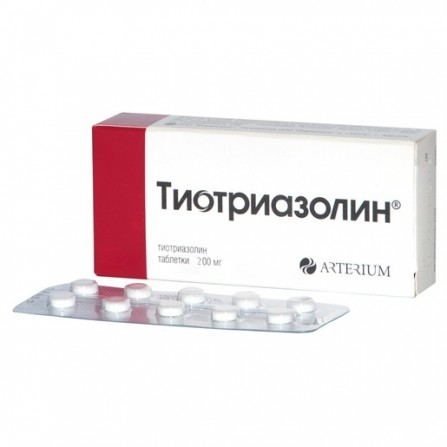Thiotriazoline pills 200mg N90
Condition: New product
990 Items
Rating:
Be the first to write a review!

More info
Active ingredients
Morpholinium-methyl-triazolyl-thioacetate
Release form
Pills
Composition
Morpholinium-methyl-triazolyl-thioacetate 200 mg; Excipients: potato starch 16 mg, low molecular weight povidone 8 mg, sucrose 5.6 mg, microcrystalline cellulose 8 mg, calcium stearate 2.4 mg.
Pharmacological effect
Metabolic agent with cardio - and hepatoprotective action. It has anti-ischemic, membrane-stabilizing, antioxidant and antianginal activity.; Prevents damage and death of hepatocytes, reduces the level of fatty infiltration and the prevalence of centrolobular liver necrosis, activates the processes of reparative regeneration of hepatocytes, normalizes protein, carbohydrate, lipid, and lipid and regeneration processes of hepatocytes in them; Accelerates the synthesis and secretion of bile, normalizes its chemical composition. Thiotriazoline increases the compensatory activation of anaerobic glycolysis, reduces the inhibition of oxidation processes in the Krebs cycle while maintaining ATP reserves. It activates the antioxidant system and inhibits lipid oxidation in ischemic sites of the myocardium, reduces the sensitivity of the heart muscle to catecholamines, interferes with the progression of inhibition of the contractile activity of the heart, stabilizes and reduces the size of the necrosis and myocardial ischemia. Improves the rheological properties of blood due to the activation of the fibrinolytic system.; Antioxidant properties are manifested due to the presence in the structure of the thiotriazoline molecule sulfur thiol, which has redox properties, and tertiary nitrogen, which binds an excess of hydrogen ions. Thiotriazoline reacts with reactive oxygen species and lipid radicals due to the pronounced reducing properties of the thiol group and prevents the initiation of reactive oxygen species by reactivating antiradical enzymes such as superoxide dismutase, catalase and glutathione peroxidase.
Pharmacokinetics
When taken orally, the relative bioavailability is 64.5%, the period of semi-absorption is 0.28 h, T1 / 2 is 1.3 h, Cmax in the blood plasma is noted after 1.18 h, binding to plasma proteins does not exceed 10%. After i / v administration, Cmax in the blood plasma is noted after 0.1 h, with i / m - after 0.84 h.A significant amount accumulates in the myocardium, the tissues of the liver, spleen, kidneys and rectum, in small quantities in the lungs and small intestine. Excreted mainly by the kidneys.
Indications
Chronic hepatitis of various etiologies, cirrhosis of the liver; IHD: acute myocardial infarction (as part of complex therapy), exertional angina and rest angina, post-infarction cardiosclerosis, chronic heart failure, cardiomyopathy (as part of complex therapy), heart rhythm disturbances.; Functional diseases of the heart vascular system (including neurocirculatory dystonia), myocardial dystrophy, tonsilogenic cardiopathy (as part of complex therapy) .; Acute viral hepatitis, chronic hepatitis of various etiologies, cirrhosis of the ne tim;. The use for the purpose of detoxification when receiving drugs with severe hepatotoxicity.
Contraindications
Renal failure, children under 5 years of age, pregnancy, breastfeeding, hypersensitivity to thiotriazoline.
Use during pregnancy and lactation
Contraindicated use during pregnancy and lactation (breastfeeding).
Dosage and administration
When ingested for adults a single dose - 100-200 mg, the frequency of admission - 3-4 times / day. For children - 10–20 mg / kg / day in 3 doses.; 50 mg 2–3 times / day is administered by V / m; 100 mg is slowly administered in a dose of 100 mg 1 time / day; B / in drip administered in a dose of 20-50 mg.; Duration of treatment is determined individually depending on the severity and course of the disease.
Side effects
Side effects are possible with the / m or / in the introduction.; Rarely: itching, skin flushing, fever, skin rash (urtikarnaya, papular, small-point, spotted); while taking with other drugs, isolated cases of urticaria and angioedema, 1 case of anaphylactic shock are described. Very rarely (in patients, mostly elderly, while using with other drugs): general weakness, dizziness, tinnitus, tachycardia, arterial hypertension, dry mouth, nausea, bloating, vomiting, shortness of breath, choking.
Overdose
Cases of overdose are unknown. When ingestion of a large amount of the drug - it is necessary to make a gastric lavage. Symptomatic treatment.
Interaction with other drugs
Thiotriazoline as a cardioprotective agent can be combined with the basic means used for the treatment of coronary artery disease; as a hepatoprotective agent - combined with traditional methods of treatment of hepatitis.
special instructions
The pills contain sucrose - 2.8 mg per tablet, i.e. The maximum daily dose (8 pills) contains 22.4 mg of sucrose, which should be considered in patients with diabetes.





